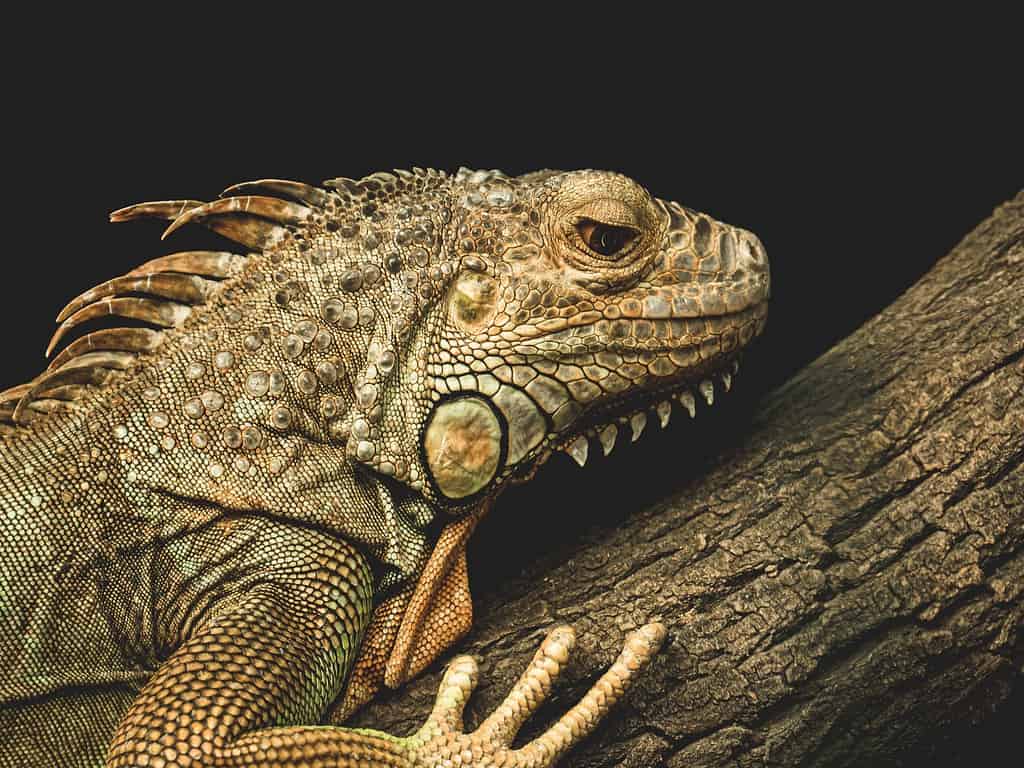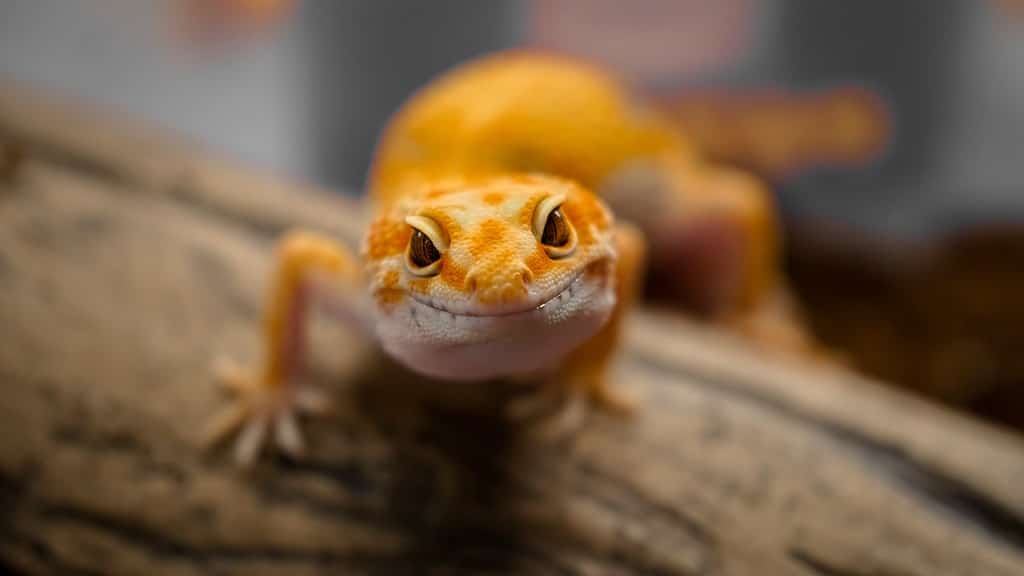
Why do we so often think lizards are meat-lovers, when the truth is far more intriguing? If you’ve ever wondered what lizards eat, prepare to be surprised. These scaly wonders are culinary explorers, feasting on a smorgasbord of options that range from crunchy insects to succulent fruits. Their dining habits are as diverse as their vibrant scales, debunking the myth that they’re solely carnivorous critters.
Lizards are usually carnivorous — but sometimes, omnivorous or herbivorous
You probably won’t be shocked to learn that many lizards eat insects. In fact, critters like crickets, beetles, and ants form the staple diet for a multitude of lizard species. But the story doesn’t end there. The lizard menu is far more expansive and diverse than you might think. Some lizards feast on fruits and flowers, while others prefer a meatier dish like small mammals and even other lizards. Yes, you heard it right—some lizards are cannibalistic.
But that doesn’t even begin to describe how diverse their feeding patterns can be.
From inconsequential captures like ants and flies to even each other, the world of lizard diets is eclectic, to say the least. You might’ve seen the phrase ‘eat the rainbow’ pop up on social media occasionally. Well, lizards, as a group, follow this philosophy pretty well. Depending on the species, lizards can be either carnivorous, omnivorous or even herbivorous.
This remarkable range of dietary preferences shapes not only their survival strategies but also plays a crucial role in maintaining ecological balances in their habitats and ecosystems.
What do lizards eat: Classifying Lizards Based on their Diets
Contrary to the image conjured by Hollywood’s towering Godzilla, not all lizards are carnivorous, stalking their prey with the fervor of apex predators. You might think that crickets, beetles, and ants are the culinary staples for these reptiles, but the lizard palate is a lot more nuanced than you might imagine. From fruits and flowers to small mammals and even fellow lizards—yes, cannibalism exists in lizard-land—their diet is incredibly varied.
While carnivory in lizards is prevalent for sure, not all of them strike fear in the hearts of prey around. On the flip side, lizards like the green iguana (Iguana iguana), large as they are, would rather just munch on leafy greens instead. So, traditionally lizards have been categorized into three main feeding groups: carnivores, omnivores, and herbivores.
We’ll focus on wild lizards first, and then move on to captive lizards.
Carnivorous lizards examples
Carnivorous lizards come in a variety of shapes, sizes, and habitats, and each has its own unique hunting methods and prey preferences. Here’s a list of some notable carnivorous lizards:
- Komodo Dragon: Primarily feeds on large mammals like deer and water buffalo, as well as carrion.
- Monitor Lizard: Eats a varied diet including insects, birds, small mammals, and fish.
- Gila Monster: Consumes eggs, small mammals, and birds. Known for its venomous bite.
- Beaded Lizard: Feeds on small mammals, birds, and eggs. Another venomous species.
- Collared Lizard: Eats insects, smaller lizards, and occasionally small mammals.
- Some Species of Iguanas: While generally herbivorous, some are more opportunistic and eat insects, small animals, and eggs.
- Horned Lizard: Specializes in eating ants, but will also consume beetles and other small insects.
- Frilled Lizard: Mainly eats insects but will also go for smaller vertebrates.
Omnivorous lizards

These lizards have evolved to eat a wide range of foods, providing them with the flexibility to adapt to various environments and conditions. Their varied diets make them particularly interesting subjects of study for herpetologists and ecologists alike. Species like the garden skink, and various geckos — all of whom are commonly found in our homes — including the well-known leopard gecko, are prime examples of ubiquitous omnivorous lizards.
- Green Anole: Consumes a diet of insects like crickets and flies, but also eats fruit and nectar.
- Blue-Tongued Skink: Eats a variety of foods including insects, fruits, and vegetables.
- Water Dragon: Feeds on insects, small fish, and small mammals, but will also eat fruits and vegetation.
- Bearded Dragon: Consumes crickets, mealworms, and other insects as well as fruits and vegetables.
- Spiny-Tailed Iguana: Eats a mix of insects and plants, including flowers and leaves.
- Chuckwalla: Primarily eats vegetation but will occasionally consume insects.
- Brown Anole: Feeds on a mix of insects and plant matter like fruit.
- Day Gecko: Eats insects and other small invertebrates but also consumes nectar and ripe fruit.
- Curly-Tailed Lizard: Consumes both plant matter and animals, ranging from fruits and seeds to insects and small vertebrates.
- European Wall Lizard: Diet includes insects, small invertebrates, fruits, and other plant material.
Herbivorous lizards
Herbivorous lizards have adapted to a plant-based diet in many fascinating ways, from specialized jaw structures to digestive systems optimized for breaking down fibrous plant material. Each of these species plays an important role in its respective ecosystem, often aiding in seed dispersal and vegetation control.Several species of iguanas, such as the popular green iguana and the desert iguana, are primarily herbivores, with some possibly being obligate herbivores.
What do captive lizards eat
Lizards are wild creatures, but it’s not that uncommon for people to have them at home. It’s important to distinguish between wild lizards and pet or captive lizards when discussing their dietary preferences. Although both have similar needs, captive lizards do not face many of the pressures that wild lizards do and hence require different diets. For this, you should always contact your local veterinarian to get the best advice.
However, there are some generally good practices that you can follow.
Lizards exhibit diverse eating habits, reflecting their varied natural habitats, sizes, and body structures. When catering to a lizard’s dietary needs, keep these key points in mind:
- Try to mimic the lizard’s natural diet as closely as possible.
- Offer food that is appropriately sized and presented for the specific species.
- Make sure insects or other prey like snails haven’t been exposed to pesticides.
Smaller lizard species mostly eat insects. Offer a wide range of live insects, and consider boosting their nutritional value by feeding them a mixture that’s 80% cricket food and 20% calcium carbonate a few days before offering them to the lizard.
Omnivorous lizards might enjoy a diet that includes not just insects but also plants and produce like clover, dandelion, and various fruits and vegetables such as bananas, apples, and lettuce. Some may even eat small quantities of moistened dry dog food or canned dog food.
As for feeding schedules, lizards usually eat every two to three days. They are more active than snakes and have a faster metabolism, necessitating frequent, smaller meals, especially in warm weather.
Lastly, a lizard’s ability to digest food is heavily influenced by the temperature of its environment. Maintain optimal temperature conditions to prevent issues like regurgitation or food decomposition in the stomach.
Dietary Diversity
From insect-hunting chameleons to leaf-munching iguanas, the diets of lizards are as diverse and vibrant as the scales that adorn their bodies.
However, even within the broad categories of carnivory, omnivory, and herbivory, diet varies significantly. For instance, not all carnivorous lizards eat the same kinds of meat.
Take, for example, species from the Varanus genus, like the renowned Komodo Dragons (Varanus komodoensis). These massive reptiles are full-fledged carnivores, relying on a diet rich in small mammals, birds, and reptiles. In contrast, smaller lizards from other carnivorous genera, such as the Aspidoscelis genus, are primarily insectivorous.
Similarly, the same logic applies to omnivores and herbivores. Essentially, no two lizards — feeding behavior aside — have identical dietary preferences.
Variations in feeding behaviors
Just as there exists remarkable variation in dietary preferences within feeding behaviors — like carnivory, omnivory, and herbivory — even the feeding behaviors themselves aren’t fixed or rigid. Depending on various factors like resource availability, lizards can switch up from fixed patterns of carnivory and herbivory into a more omnivore habit.

For instance, take the Green Anole (Anolis carolinensis). These small reptiles are primarily insectivorous and feed on flies and ants and crickets on the regular yet they also don’t shy away from consuming small fruits and feeding on nectar as and when the opportunity arises.
Factors that define lizard diets
Lizards have successfully colonized every continent on Earth — well, except Antarctica. Aversion to snowy habitats aside, these vertebrates have an exceptional adaptability that allows them to thrive in a variety of diverse habitats, ranging from arid deserts and lush rainforests to wet and humid swamps and wetlands.
Environmental and ecological factors like seasonal change, availability of resources, and predator-prey interactions, as well as various physiological and morphological adaptations, such as digestion mechanisms and dentition structures, are all vital components that contribute to the determination of a lizard’s diet.
For instance, in a paper (aptly) titled ‘Change your diet or die,’ researchers from Israel, the U.S.A., and Spain explored the effects of predator presence on the diets of omnivorous lizards. The study sheds light on how lizards’ trophic ecologies were influenced by the presence and absence of predators. One significant finding reveals that lizards under threat from predators ate more seeds compared to control lizards.
Valentín Pérez-Mellado, a researcher at the University of Salamanca, explained these changes in trophic behaviors, suggesting that they may be a tactic used by lizards to avoid predation. According to Pérez-Mellado, ‘When there is greater pressure from predators, the individuals tend to move less and catch more mobile prey from somewhat different groups. The lizards’ diet and food-seeking behavior changed significantly when we experimentally increased the predation pressure on them.
Essentially, the paper revealed that as predation pressures increased, lizards became less picky in what they consumed. Their primary focus shifted from foraging for food to simply consuming whatever was available with minimal movement to avoid detection from predators. For example, remember the seeds?
The study showed that lizards significantly increased their consumption of seeds when faced with heightened predation pressures, indicating a shift in their dietary preferences.
Conclusion
The dietary diversity of lizards is a testament to their remarkable adaptability and ecological significance. Even within the broad trophic classifications of carnivory, omnivory, and herbivory, every lizard species has its unique dietary preferences, shaped by factors like resource availability and predator pressures.
Understanding the dietary preferences and wider trophic ecology of animals, in this case, lizards also contributes to the broader field of ecology. For instance, researchers from the University of Bristol, analyzed the teeth of extant reptiles like Monitor lizards, with tooth samples of dinosaurs from the Triassic period to help understand what the earliest dinosaurs in the world fed on!






